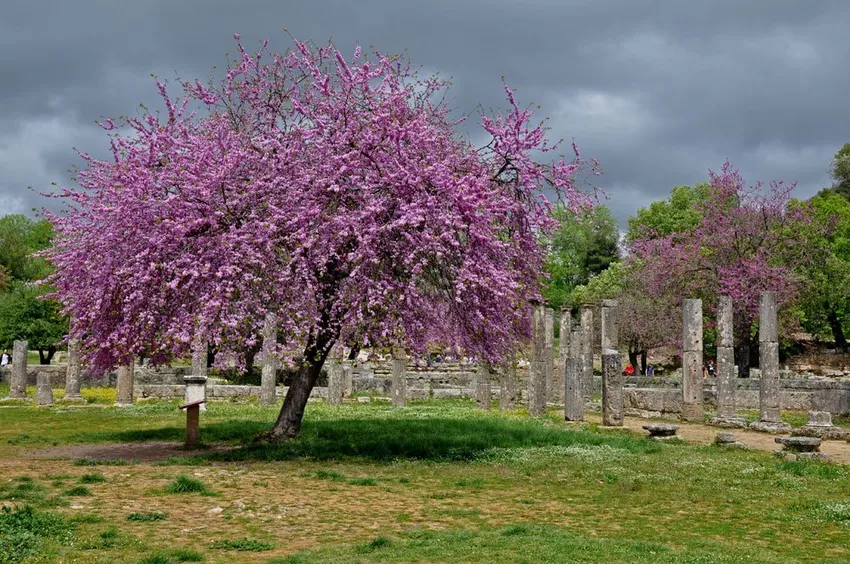Anyone who likes magnolias and cherry blossoms will love the Judas tree. Read here how to properly plant and care for a Judas tree.

Hardly any other European tree is as versatile as the Judas tree, which amazes almost every gardener at first. The decisive factor for this is his ancestry alone. The pink, orchid-like flowers not only sprout on thin branches, but also sprout on the old branches.
» Did you know:
The Judas tree got its popular name because of its rounded leaves, which are reminiscent of pieces of silver at the time of Judas, for which he once betrayed Christ. These green leaves turn a beautiful golden yellow in fall.
Judas Tree Varieties
Before you can plant a Judas tree, you must first decide on a variety. Garden stores often sell different varieties of the Judas tree. You can find the following almost everywhere:
- Canada Judas Tree - sturdier variety with reddish foliage
- Chinese Judas tree - relatively hardy variety
- Common Judas tree - very sensitive to frost when young
- Alba - produces white flowers
I recommend buying the Chinese Judas tree from a good nursery. This variety simply does best with the German climate.
However, the Judas tree is often sold under the name heart tree or love tree in garden shops.
Planting and caring for the Judas tree - This is how it's done
 If you too would like to bring this beautiful tree into your garden, then it is best to follow our instructions for growing and caring for the tree. This way you will enjoy your Judas tree for a long time.
If you too would like to bring this beautiful tree into your garden, then it is best to follow our instructions for growing and caring for the tree. This way you will enjoy your Judas tree for a long time.
Location:
The Judas tree, which belongs to the genus of legumes, grows in almost any calcareous, nutrient-rich, preferably permeable, albeit always slightly moist soil. It clearly prefers a light-flooded, sunny to only moderately semi-shady location.
Planting time:
Spring is the best time to plant young trees. Older Judas trees (from around the age of 3)but you can also plant in the fall.
» Attention:
As soon as the Judas tree feels comfortable in a location, it sometimes forms extreme root suckers (shallow roots), which you then of course have to dam. Otherwise they are strong enough to even lift pavers.
Pruning:
In addition, a Judas tree grows between 30 and 50 centimeters a year, initially upright, later forming a slightly spreading crown. Nevertheless, you should only cut back the Judas tree in its natural growth once if absolutely necessary (similar to magnolia trees). You can only remove dead branches every year in spring and/or autumn.
Fertilize:
On top of that, a Judas tree usually does not need any fertilization, as long as you have planted it in the right place. Otherwise you can, for example, help a little with acidic soil once a year with one or two tablespoons of blue grain.
Flower and fruits
 The flowering phase of the Judas tree, which grows up to around 6 meters high, begins in the early garden year, from April to May, which is why the Judas tree is one of the early bloomers. Here, the Judas tree also forms a mostly quite lush, pink cloud of flowers, with several flowers always standing in clusters. At the same time, the blue-green leaves on the tree grow, which quickly creates an optically pretty contrast.
The flowering phase of the Judas tree, which grows up to around 6 meters high, begins in the early garden year, from April to May, which is why the Judas tree is one of the early bloomers. Here, the Judas tree also forms a mostly quite lush, pink cloud of flowers, with several flowers always standing in clusters. At the same time, the blue-green leaves on the tree grow, which quickly creates an optically pretty contrast.
» Tip:
The flowers themselves can also be eaten, for example in salads, making a great contrast!
The Judas tree naturally grows as a shrub. However, you can also cut it as a spherical tree with a standard stem, or plant it as a container plant with a smaller stature. Ultimately, it is also suitable as a climbing trellis plant, which can even be used to create a green facade with the Judas tree.
After flowering, reddish-brown legume pods develop on the Judas tree, which are about 6 centimeters long and remain attached until winter. However, the seeds of the fruit are not necessarily to everyone's taste due to their idiosyncratic taste, although they would be suitable for consumption.